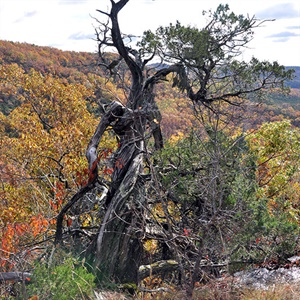Arkansas has two species of native juniper trees. The common species, which occurs statewide, is the eastern red-cedar (Juniperus virginiana). Ashe’s juniper (Juniperus ashei) is much less common, and differs from eastern red-cedar in a number of characters. The most obvious difference is its multi-trunked growth form (vs. single-trunked in eastern red-cedar). Other characters are:
- the presence of white rings or patches on the bark of Ashe’s juniper trunks and branches (vs. a lack of these patches on eastern red-cedar); this character is the source of another common name, “white cedar.”
- darker green foliage that generally stays green in winter on Ashe’s juniper (vs. olive green to yellowish green foliage often turning bronze in winter in eastern red-cedar)
- margins of scale-like leaves with fine teeth in Ashe’s juniper (vs. toothless in eastern red-cedar).
Ashe’s juniper has an interesting range, occurring primarily in the Edwards Plateau of Texas and into south-central Oklahoma. It can also be found in an outlying area of southwestern Arkansas’s chalk barrens and in the Ozark Plateau of Arkansas, Missouri, and Oklahoma. Many ecologists consider its occurrence in the Ozarks to be a holdover from a warmer, drier climatic period thousands of years ago when many western plant species migrated eastward.
In the Arkansas Ozarks, Ashe’s juniper is primarily found on the dry, steep, south- and west-facing slopes of limestone-dolomite glades in northern counties of the Ozark Plateau. They also occur on bluff tops and ledges along the White River, the Buffalo River, and other Ozark streams. Some of the bluff top junipers are hundreds of years old because these sites are especially inaccessible, and because the scrubby, gnarled growth-form of Ashe’s juniper makes it of little commercial value. The Central Interior Highlands Calcareous Glades that support this tree are a natural community of conservation concern.
Dry Chalk Outcrop Woodlands in southwest Arkansas are also known to support Ashe’s juniper. This natural community of conservation concern is unusual for Arkansas as it is typically found on the Edwards Plateau of Texas.
Ashe’s juniper is currently known from at least two of Arkansas’s natural areas—Devil’s Knob-Devil’s Backbone in Izard County, and White Cliffs in Little River County.
